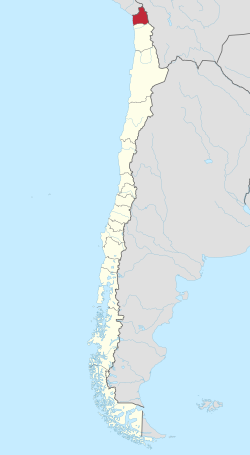Arica y Parinacota Region
Región de Arica y Parinacota | |
|---|---|
 | |
 Map of Arica y Parinacota Region | |
| Coordinates: 18°28′30″S 70°18′52″W / 18.47500°S 70.31444°W | |
| Country | |
| Capital | Arica |
| Provinces | Arica, Parinacota |
| Government | |
| • Intendant | Roberto Erpel (UDI) |
| Area | |
| • Total | 16,873.3 km2 (6,514.8 sq mi) |
| • Rank | 12 |
| Highest elevation | 6,342 m (20,807 ft) |
| Lowest elevation | 0 m (0 ft) |
| Population (2017)[1] | |
| • Total | 224,548 |
| • Rank | 14 |
| • Density | 13/km2 (34/sq mi) |
| GDP (PPP) | |
| • Total | $2.315 billion (2014) |
| • Per capita | $9,848 (2014) |
| ISO 3166 code | CL-AP |
| HDI (2019) | 0.882[3] very high |
| Website | gorearicayparinacota |
The Arica y Parinacota Region[4][5] (Spanish: Región de Arica y Parinacota pronounced [aˈɾikaj paɾinaˈkota])[6] is one of Chile's 16 first order administrative divisions. It comprises two provinces, Arica and Parinacota. It borders Peru's Department of Tacna to the north, Bolivia's La Paz and Oruro departments to the east and Chile's Tarapacá Region to the south. Arica y Parinacota is the 5th smallest, the 3rd least populous and the 6th least densely populated of the regions of Chile. Arica is the region's capital and largest city.
The region was a former Peruvian province, which was occupied by Chile under the 1883 Treaty of Ancón at the close of the War of the Pacific, and then formally annexed in 1929 by the Treaty of Lima. Following annexation, Arica y Parinacota went through a process of forced acculturation known as Chilenization with the aim of creating a dominance of Chilean traditions and culture.
- ^ a b "Arica-Parinacota Region". Government of Chile Foreign Investment Committee. Retrieved 13 March 2010.[permanent dead link]
- ^ Regions and Cities > Regional Statistics > Regional Economy > Regional GDP per Capita, OECD.Stats.
- ^ "Sub-national HDI – Area Database – Global Data Lab". hdi.globaldatalab.org. Retrieved 26 October 2021.
- ^ "Iglesias de Arica Parinacota (Churches of Arica Parinacota)". New York: World Monuments Fund. Retrieved 26 July 2012.
However, San Pedro de Esquiña, like many other churches in the Arica y Parinacota region, is at risk.
- ^ "Journalists and media professionals to participate in awareness-raising workshop on violence against women in Arica". UNESCO. 18 May 2011. Retrieved 26 July 2012.
[...] several women's public organizations and agencies from the Chilean region of Arica y Parinacota.
- ^ "Ley 20175. Crea la XV Región de Arica y Parinacota y la Provincia del Tamarugal en la Región de Tarapacá". Ley Chile (in Spanish). Valparaiso, Chile: Biblioteca del Congreso Nacional de Chile. 11 April 2007. Retrieved 26 July 2012.

